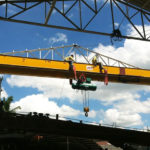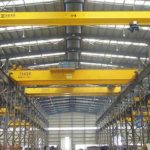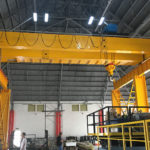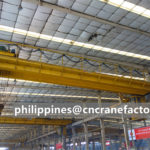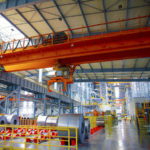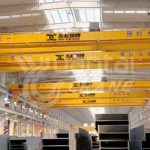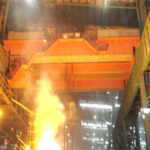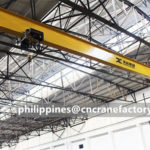Steel mill cranes efficiently handle large quantities of raw materials, molten metal and finished steel products. From the initial stages of scrap processing to the final storage of coils and beams, steel mill cranes are critical every step of the way.
This article explores the different types of steel mill cranes, their advantages and how they are used within steel mills. We can also design different lifting solutions according to the different needs of customers.
Different Types of Steel Mill Cranes
The diverse tasks within steel plants require several types of cranes, each designed for specific applications:
• Ladle Overhead Cranes: Ladle Overhead cranes travel along elevated runways, providing superior lifting capacity and large area coverage. Bridge cranes are commonly used for:
o Scrap Loading: Grabbing and transporting large quantities of scrap metal for furnace feed.
o Ladle Handling: Manipulating heavy ladles containing molten metal during the casting process.
o Slab Handling: Moving large pieces of steel plate after casting and throughout the rolling process.

• Top-running overhead crane: A special type of overhead crane, the bridge of a top-running overhead crane is supported on top of the runway track. This configuration allows for maximum hook height and lift clearance, making it ideal for applications requiring high vertical movement such as:
o Mold handling: Lifting and positioning heavy moulds used to cast molten steel.
o Coil storage and retrieval: Stacking and retrieval of finished steel coils in high-bay warehouses.

• Under-suspension overhead crane: An under-suspension overhead crane is suspended from the base of the building structure. They are ideal for areas with limited overhead runway space and are typically used for:
o Maintenance Tasks: Lift and transport heavy tools and equipment to perform repair and maintenance activities throughout the facility.
o Specific workstations: Provide dedicated lifting capabilities within a designated area, such as a processing station or inspection area.

• EOT Crane (Electric Overhead Crane): EOT cranes are powered by electricity, providing precise control and smooth operation. They are available in a variety of configurations, including overhead, top-running bridge and underslung, making them highly versatile to meet the needs of different steel mills.

• Electromagnetic Overhead Cranes: Electromagnetic overhead cranes are equipped with powerful magnets specifically designed to handle black (ferrous) materials. They require no slings or hooks, allowing efficient and safe handling of scrap, slabs and coils. Magnetic cranes are particularly suitable for:
o Scrap processing: sorting and separating ferrous scrap from non-ferrous materials.
o Loading Furnace: Quickly and safely load scrap metal into the furnace for melting.

Advantages of Different Steel Plant Cranes
Each crane type offers unique advantages to meet the specific requirements of a steel mill:
- Ladle overhead cranes: Ladle overhead cranes offer superior lifting capabilities and wide coverage, making them ideal for heavy-duty tasks such as ladle and slab handling.
- Top-running overhead crane: Offers maximum hook height and lifting clearance, ideal for applications requiring high vertical movements such as mould handling and coil storage.
- Under-suspension bridge crane: Optimizes space utilization in areas with limited headroom, suitable for dedicated lifting in specific working areas.
- EOT Crane: Provides precise control and smooth operation through electricity, ensuring safe and efficient material handling.
- Electromagnetic overhead crane: Speeds up scrap processing and furnace charging by eliminating the need for manual grabs and ensuring safe handling of ferrous materials.
How to Use Steel Mill Crane?
Steel mill cranes play a key role in every stage of steel production:
- Raw Material Handling: Bridge cranes with grapple attachments effectively grab and transport scrap metal to feed furnaces. Electromagnetic bridge cranes are particularly good at sorting and separating ferrous scrap from other materials.
- Molten metal management: Heavy-duty overhead cranes equipped with specialized ladles carefully manipulate the molten metal during the casting process. These cranes require excellent heat resistance and rugged construction to withstand harsh environments.
- Semi-finished products handling: Bridge cranes help in handling semi-finished products like slabs and billets through various rolling and forming processes. Precise positioning and smooth operation are essential for a seamless production process.
- Finished product handling: Top-running overhead cranes with high lifting capacity facilitate stacking and retrieval of finished steel coils in overhead storage facilities. Electromagnetic bridge cranes are also used for efficient coil handling.
- Maintenance and repair: Underslung bridge cranes provide dedicated lifting support for maintenance tasks throughout the plant. They assist in lifting and transporting heavy tools, equipment and replacement parts.
How to Choose the Best Steel Mill Crane for You?
Choosing the most suitable crane for your steel mill requires careful consideration of several factors:

- Lifting capacity:
• Lifting Capacity: This refers to the maximum weight that the crane can safely lift. Steel plants need cranes with a wide range of capabilities, from cranes that handle lighter scrap metal to behemoths that manipulate large ladles of molten metal.
• Span: This is the horizontal distance covered by the main girder of the crane. Consider the size and layout of your facility and select a crane with a span sufficient to cover the designated work area. - Lifting environment:
• Task Type: Determine the main tasks the crane will perform. Overhead cranes are ideal for general material handling while top-running overhead cranes excel in high-clearance applications. Underslung cranes are suitable for designated work areas, while electromagnetic cranes are specifically designed to handle ferrous materials.
• Temperature and environment: Steel plant environments are hot and dusty. Make sure the crane you choose is designed for such conditions and uses heat-resistant materials and encapsulated electrical components. - Working class:
• Speed: Consider the speed required for lifting and travel movements. Faster cranes can improve overall productivity, but prioritize safety and stability over speed.
• Control System: Modern cranes offer advanced control systems for precise positioning and smooth operation. Choose a system that matches the operator’s skill level and offers features that increase safety and productivity. - Automated control:
The steel industry is increasingly adopting automation to improve efficiency and safety. If repetitive tasks are involved, such as scrap loading or coil handling, consider a crane with automation capabilities.
Optimizing Steel Mill Crane Operations
By carefully selecting the right crane type for your specific needs, you can significantly improve your steel plant’s efficiency, safety and productivity. Here are some additional considerations for optimizing crane operations:
- Conduct a thorough site assessment: Evaluate the facility’s layout, capacity requirements and environmental conditions before selecting a crane.
- Create a preventive maintenance plan: Regular maintenance ensures smooth operation, minimizes downtime and extends the life of your crane.
- Operator Training: Proper training equips operators with the skills needed to operate the crane safely and efficiently.
Excellent Steel Mill Crane Solution
The world of steel mill cranes extends beyond the core types discussed previously. Here are some professional solutions for unique needs:
• H-Frame Cranes: These cranes feature a unique H-shaped bridge structure that provides superior rigidity and stability. They are typically used in heavy-duty applications in harsh environments such as:
o Slab Casting: Precise positioning of moulds and handling of molten metal during continuous slab casting.
o Coil Processing: * Supports high-capacity lifting and manipulation of heavy coil materials on processing lines.
• Gantry Cranes: These cranes are self-supporting structures whose legs run on rails. Ideal for outdoor applications or areas with limited top support, they are typically used for:
o Loading and Unloading: Efficiently process materials such as scrap metal or finished goods in outdoor yards.
o Heavy Equipment Maintenance: Provide lifting support for maintenance and repair of large machinery outside the main plant.
• Stacking Cranes: These specialized cranes are designed for automated storage and retrieval systems. They efficiently stack and retrieve materials such as steel plates or coils within high-bay warehouses, optimizing space utilization.
Development and Innovation of Steel Plant Cranes
The steel industry is constantly evolving, and so is crane technology. Here are the advancements in steel mill cranes:
- Smart cranes: Integrating sensors and data analytics into cranes enables real-time monitoring of performance, predictive maintenance and improved operational efficiency.
- Remote operation: Cranes equipped with Remote Control capabilities allow for safer operation in hazardous environments and the potential for increased automation.
- Lightweight, high-strength materials: Advances in materials science have led to lighter yet stronger crane structures, increasing lifting capacity without compromising manoeuvrability.
Our Yuantai Crane Company has been exporting overhead cranes, gantry cranes, jib cranes and electric hoists to the Philippines and other Southeast Asian countries as well as countries around the world for more than ten years. We have very rich experience and a green crane manufacturing industry chain. contact us to get free crane solutions and free quotations, and look forward to our friendly cooperation!
